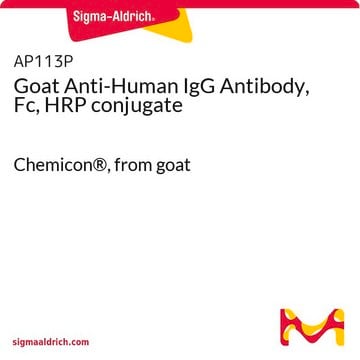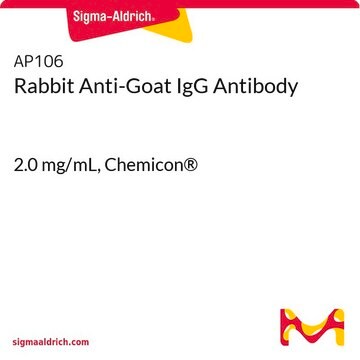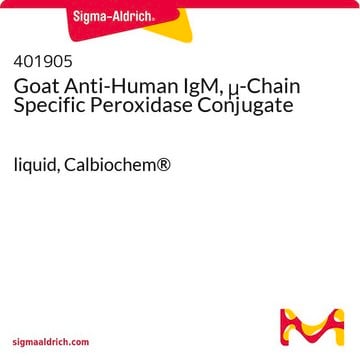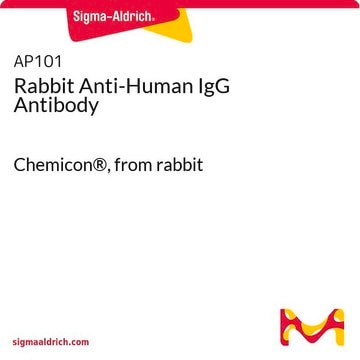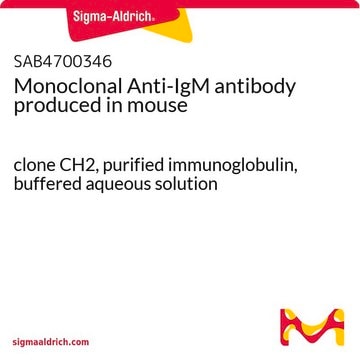MABX1901
Anti-human IgG (1mg) KC
from mouse
Iniciar sesiónpara Ver la Fijación de precios por contrato y de la organización
About This Item
Código UNSPSC:
12352203
eCl@ss:
32160702
NACRES:
NA.41
Productos recomendados
origen biológico
mouse
forma del anticuerpo
purified antibody
tipo de anticuerpo
secondary antibodies
clon
monoclonal
reactividad de especies
human
técnicas
ELISA: suitable
immunodiffusion: suitable
isotipo
IgG2b
Descripción general
Secondary antibody specific for Human Immunoglobulin G
Immunoglobulin G (IgG), an immunoglobulin isotype, is the most abundant protein in human serum and constitutes 10-20% of plasma protein. It is composed of glycoproteins comprising 82-96% of proteins and 4-18% of carbohydrates. IgG is further classified into IgG1, IgG2, IgG3, and IgG4 subclasses. IgG consists of four polypeptide chains, with two heavy chains (γ chains) and two light chains (κ or λ chains), which are linked by inter-chain disulfide bonds. It is secreted by B lymphocytes and found in extracellular fluids and blood.
Immunoglobulin G (IgG), an immunoglobulin isotype, is the most abundant protein in human serum and constitutes 10-20% of plasma protein. It is composed of glycoproteins comprising 82-96% of proteins and 4-18% of carbohydrates. IgG is further classified into IgG1, IgG2, IgG3, and IgG4 subclasses. IgG consists of four polypeptide chains, with two heavy chains (γ chains) and two light chains (κ or λ chains), which are linked by inter-chain disulfide bonds. It is secreted by B lymphocytes and found in extracellular fluids and blood.
Especificidad
Specific for Human IgG. No cross reactivity with human IgA, IgD, IgE or IgE.
Inmunógeno
corresponding to Human Serum IgG.
Aplicación
Detect Human Serum IgG using this mouse monoclonal Anti-human IgG (1mg) KC, Cat. No. MABX1901-1KC, validated for use in Lateral Flow Assay and ELISA.
Acciones bioquímicas o fisiológicas
Immunoglobulin G (IgG) primarily contributes to the humoral immune response by neutralizing pathogens such as bacteria, viruses, and protect cells from their toxic substances. IgG is the only isotype transferred to the fetus across the placenta and is vital for immune response of the neonate. Alterations in IgG fragment crystallizable (Fc)-glycosylation are associated with various diseases including rheumatoid arthritis and tuberculosis.
Calidad
Tested
Forma física
Format: Purified
Otras notas
Concentration: Please refer to lot specific datasheet.
Not finding the right product?
Try our Herramienta de selección de productos.
Código de clase de almacenamiento
12 - Non Combustible Liquids
Clase de riesgo para el agua (WGK)
WGK 2
Punto de inflamabilidad (°F)
Not applicable
Punto de inflamabilidad (°C)
Not applicable
Certificados de análisis (COA)
Busque Certificados de análisis (COA) introduciendo el número de lote del producto. Los números de lote se encuentran en la etiqueta del producto después de las palabras «Lot» o «Batch»
¿Ya tiene este producto?
Encuentre la documentación para los productos que ha comprado recientemente en la Biblioteca de documentos.
Los clientes también vieron
The N-glycosylation of mouse immunoglobulin G (IgG)-fragment crystallizable differs between IgG subclasses and strains.
de Haan N, et al.
Frontiers in immunology, 8, 608-608 (2017)
Noortje de Haan et al.
Frontiers in immunology, 8, 608-608 (2017-06-18)
N-linked glycosylation of the fragment crystallizable (Fc)-region of immunoglobulin G (IgG) is known to have a large influence on the activity of the antibody, an effect reported to be IgG subclass specific. This situation applies both to humans and mice.
Ratcliffe, M. J.
Encyclopedia of Immunology (2016)
Placental transfer of IgG subclasses in a Japanese population.
Hashira S, et al.
Pediatrics International, 42(4) (2000)
Gestur Vidarsson et al.
Frontiers in immunology, 5, 520-520 (2014-11-05)
Of the five immunoglobulin isotypes, immunoglobulin G (IgG) is most abundant in human serum. The four subclasses, IgG1, IgG2, IgG3, and IgG4, which are highly conserved, differ in their constant region, particularly in their hinges and upper CH2 domains. These
Nuestro equipo de científicos tiene experiencia en todas las áreas de investigación: Ciencias de la vida, Ciencia de los materiales, Síntesis química, Cromatografía, Analítica y muchas otras.
Póngase en contacto con el Servicio técnico

